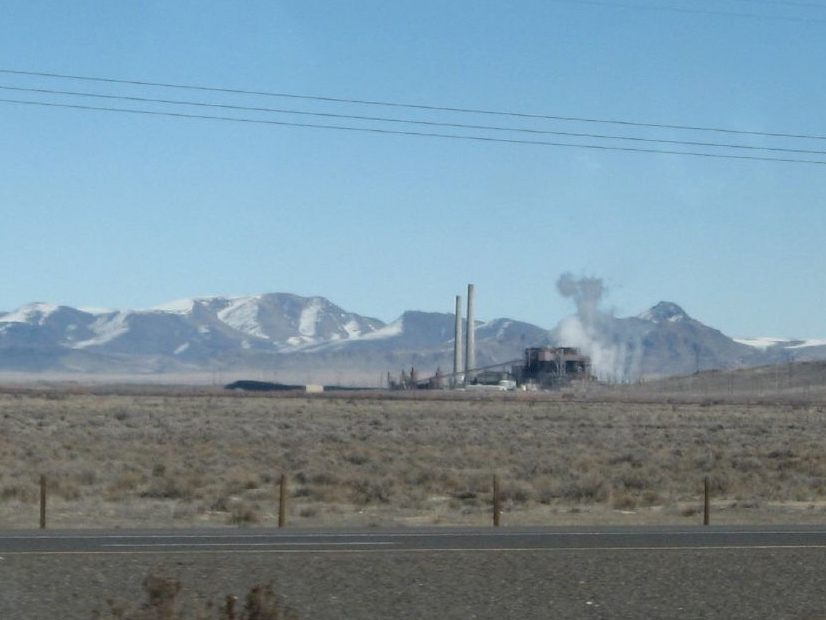
Nevada regulators approved NV Energy’s plan to convert its last coal-fired power plant to natural gas, while also allowing the company to move forward with a $1.5 billion, 400-MW solar-plus-storage project.
Approval of the solar-plus-storage project, known as Sierra Solar, may allow the utility to reduce an open position that’s been described as one of the largest in the West. NV Energy is developing the project, which would be about 15 miles northeast of Fernley in northern Nevada.
But whether Sierra Solar will be built remains to be seen.
In an order approved March 1, the Public Utilities Commission of Nevada (PUCN) set conditions on Sierra Solar including payment of damages to ratepayers if the project is delayed or doesn’t perform as expected.
The order admonished NV Energy for arguing that it needed to move forward quickly with the project, then balking at conditions. It quoted NV Energy’s response when asked about a maximum project cost: “If the commission … feels like it has to have an upper limit on costs, we’ll assess if we think it’s reasonable and whether we can move forward with the project or not.”
“The commission is persuaded that there is a resource adequacy need necessitating consideration of the Sierra Solar project now and is troubled by the suggestion that this need may be ignored unless NV Energy gets the terms that it desires for the Sierra Solar project,” the commission wrote in its order.
In a news release after the commission’s vote, NV Energy said it “is diligently reviewing the conditions the commission placed upon the project.”
Planning Process Questioned
NV Energy proposed the Sierra Solar project through the fifth amendment to its 2021 Integrated Resource Plan. The amendment also proposed the conversion of the North Valmy Generating Station, NV Energy’s last coal-fired plant, to run on natural gas through 2049.
PUCN largely approved the amendment, despite objections of stakeholders who said the projects should go through a more comprehensive evaluation as part of the utility’s 2024 IRP that will be filed this year.
Instead, the utility has resorted to “crisis planning” through multiple amendments to the IRP, said Emily Walsh, clean energy policy adviser at Western Resource Advocates. Walsh noted that the cost of projects proposed in the fifth amendment far exceeded that of projects in the 2021 IRP.
“They’ve really been gaming the IRP process,” Walsh told RTO Insider.
In addition to approving Sierra Solar and the North Valmy conversion, the commission authorized a 2049 retirement date for two gas-fired units at the Tracy power plant, which had been scheduled for closure in 2031.
But the commission declined to approve an asset purchase agreement for future development of the 149-MW Crescent Valley solar-plus-storage project about 50 miles from the Valmy plant. Because the project is at an early stage, the utility can bring the proposal back as part of its 2024 IRP, the commission said.
Open Position
One of the drivers behind NV Energy’s proposals was to reduce its open position — resource needs that are met through short-term market purchases rather than by utility-owned resources or long-term contracts.
In a survey of 13 Western utilities, NV Energy’s projected open position in 2025 was 1,092 MW, second only to that of PacifiCorp’s 1,637 MW, according to testimony filed with PUCN on behalf of the utility. As a percentage of peak demand, NV Energy’s open position was 13%, ranking sixth out of the 13 utilities.
Proposals in NV Energy’s IRP amendment would reduce its open position to 820 MW in 2026, representing 10% of peak demand.
The commission’s order also addressed NV Energy’s participation in the Western Resource Adequacy Program, directing the utility to postpone its financially binding season from winter 2026/27 to winter 2027/28.
“NV Energy’s [forecast] open position for the summer of 2027, with or without commission approval for the requests in this docket, would subject NV Energy to substantial penalties that could be passed on to ratepayers,” the commission wrote.
Valmy Solution
In its 2021 IRP, NV Energy planned to replace capacity from the coal-fired North Valmy Generating Station with the Iron Point and Hot Pot solar-plus-storage projects. The utility plans to end coal combustion at Valmy by the end of 2025.
But supply chain issues derailed the solar projects, according to the utility, which then proposed a 200-MW battery storage project as a partial solution for the Valmy retirement. The commission rejected the proposal, asking NV Energy to come back with a complete solution for Valmy. (See NV Energy Rejected on Plan to Replace Coal Plant with Storage.)
In its March 1 order, the commission approved the plan to convert Valmy to natural gas but granted only $50 million of the $83 million NV Energy wanted for the project.
The $50 million is NV Energy’s actual costs for the project, the commission said, while the remaining $33 million is “just a placeholder amount associated with upgrades that may be needed at some point in the future.”
NV Energy plans to split the cost of the Valmy conversion with Idaho Power, which is 50% owner of the plant.
NV Energy acknowledged that it initially didn’t consider a gas conversion for Valmy. But a new transmission study found that an area called the Carlin Trend needs voltage support from a firm dispatchable resource.
The commission said the Carlin Trend constraint is “a real condition.” In addition, “without Valmy, there is a high probability Nevada would have experienced rolling blackouts three out of the last four years,” the commission stated in its order.
Once NV Energy’s Greenlink West transmission line is completed, the Valmy plant may be able to run less often, the commission noted.


